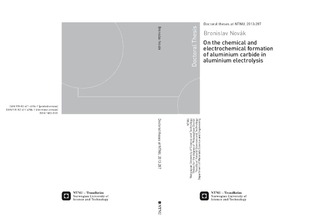| dc.contributor.author | Bronislav, Novák | nb_NO |
| dc.date.accessioned | 2014-12-19T13:27:47Z | |
| dc.date.available | 2014-12-19T13:27:47Z | |
| dc.date.created | 2013-11-21 | nb_NO |
| dc.date.issued | 2013 | nb_NO |
| dc.identifier | 666317 | nb_NO |
| dc.identifier.isbn | 978-82-471-4704-7 (printed version) | nb_NO |
| dc.identifier.isbn | 978-82-471-4706-1 (electronic version) | nb_NO |
| dc.identifier.uri | http://hdl.handle.net/11250/249424 | |
| dc.description.abstract | Cathode wear is considered as one of the key factors for limiting the lifetime of aluminium electrolysis cells. This phenomenon has become more important as aluminium smelters have steadily increased the amperage of the cells and shifted towards graphitized cathode materials with higher electrical conductivity. The present work has focused on the fundamentals of the formation of aluminium carbide at the carbon-aluminium interface. The objective was to investigate the mechanism(s) of the formation of Al4C3 and the influence of reaction parameters such as temperature, presence of cryolite and electrical current. The reaction between aluminium and carbon was first examined by diffusion couples experiments. Formation of aluminium carbide was observed at the interface after annealing at 1100 °C or higher temperatures. Two distinct layers of aluminium carbide could be observed at the interface by optical and electron microscopy. The composition of the two layers was confirmed by EDS element mapping, and the analysis revealed a relative high oxygen content in the layer towards Al and a lower oxygen content in the layer towards C. Based on a thermodynamic analysis it was suggested that the reaction may proceed by transport through the gas phase due to volatile species, which is also important for the removal of the oxide scale on the surface of molten aluminium. The influence of cryolite on the reaction of Al and C was examined also by introduction of a thin film at the Al/C interface. The presence of a catalytic amount of cryolite changed dramatically the reaction, and an aluminium carbide layer was found at the carbon surface already after 3 hours at 1030 °C. Needle-like crystals of aluminium carbide were found towards aluminium, while cryolite was not found due to the significant vapour pressure of NaAlF4(g). When a higher volume of molten cryolite was present in the crucible, the formation of Al4C3 was slowed down. The influence of applying an electric current through the diffusion couple was also investigated, and the carbon material was cathodically polarized. Formation of aluminium carbide could not be confirmed in these experiments without cryolite present at the interface. The cell voltage was however oscillating during the experiment, which could be explained by a periodically formation and fracture of aluminium carbide at the interface contact points. When catalytic amount of cryolite was introduced at the Al/C interface, the observations were similar to experiments without polarization, but the amount of aluminium carbide formed was higher, which suggests that the current passing through the diffusion couple enhances the formation of aluminium carbide. Finally, electrolysis experiments were performed in electrochemical cells with various setups of the electrodes. First a conventional cell analogue to industrial cells was used. Second, an inverted cell with opposite polarization was applied, where the cathode was exposed directly to the bath. Finally, an inverted cell was applied without Al metal present initially. These electrolysis experiments demonstrated quite similar results, where an aluminium carbide layer was found along the entire cathode surface already after 30 minutes of electrolysis. In case of the inverted cell without aluminium, the carbide layer was thinner compared to other cells, which was explained by higher amount of bath in the vicinity of the cathode leading to faster dissolution of the carbide layer. Analysis of the interior of the cathodically polarized carbon materials revealed that the molten bath infiltrated the cathode and that aluminium carbide was formed on the walls of the pores, while no Al metal was found. Aluminium carbide was suggested to be deposited electrochemically directly from the bath without involvement of the aluminium pad. The present work has demonstrated that the formation of aluminium carbide by an electrochemical reaction is significantly faster than a purely chemical reaction between the two elements. The role of cryolite for the carbide formation is twofold. Cryolite is involved as a reactant in the electrochemical formation of aluminium carbide and it also works as a solvent of the carbide. Finally, it is proposed that the exchange rate of the molten bath between the carbon cathode and the aluminium pad is the rate determining step for the cathode wear rate. | nb_NO |
| dc.language | eng | nb_NO |
| dc.publisher | Norges teknisk-naturvitenskapelige universitet, Fakultet for naturvitenskap og teknologi, Institutt for materialteknologi | nb_NO |
| dc.relation.ispartofseries | Doktoravhandlinger ved NTNU, 1503-8181; 2013:287 | nb_NO |
| dc.relation.haspart | Novak, Bronislav; Tschöpe, Kati; Ratvik, Arne Petter; Grande, Tor. Fundamentals of Aluminum carbide formation. Light Metals. (ISSN 0147-0809): 1343-1348, 2012. <a href='http://dx.doi.org/10.1002/9781118359259.ch232'>10.1002/9781118359259.ch232</a>. | nb_NO |
| dc.relation.haspart | Novak, Bronislav; Tschöpe, Kati; Ratvik, Arne Petter; Grande, Tor. The effect of cryolite on the formation of aluminum carbide at the carbon aluminum interface. Light Metals. (ISSN 0147-0809): 1245-1250, 2013. <a href='http://dx.doi.org/10.1002/9781118663189.ch210'>10.1002/9781118663189.ch210</a>. | nb_NO |
| dc.title | On the chemical and electrochemical formation of aluminium carbide in aluminium electrolysis | nb_NO |
| dc.type | Doctoral thesis | nb_NO |
| dc.contributor.department | Norges teknisk-naturvitenskapelige universitet, Fakultet for naturvitenskap og teknologi, Institutt for materialteknologi | nb_NO |
| dc.description.degree | PhD i materialteknologi | nb_NO |
| dc.description.degree | PhD in Materials Science and Engineering | en_GB |
